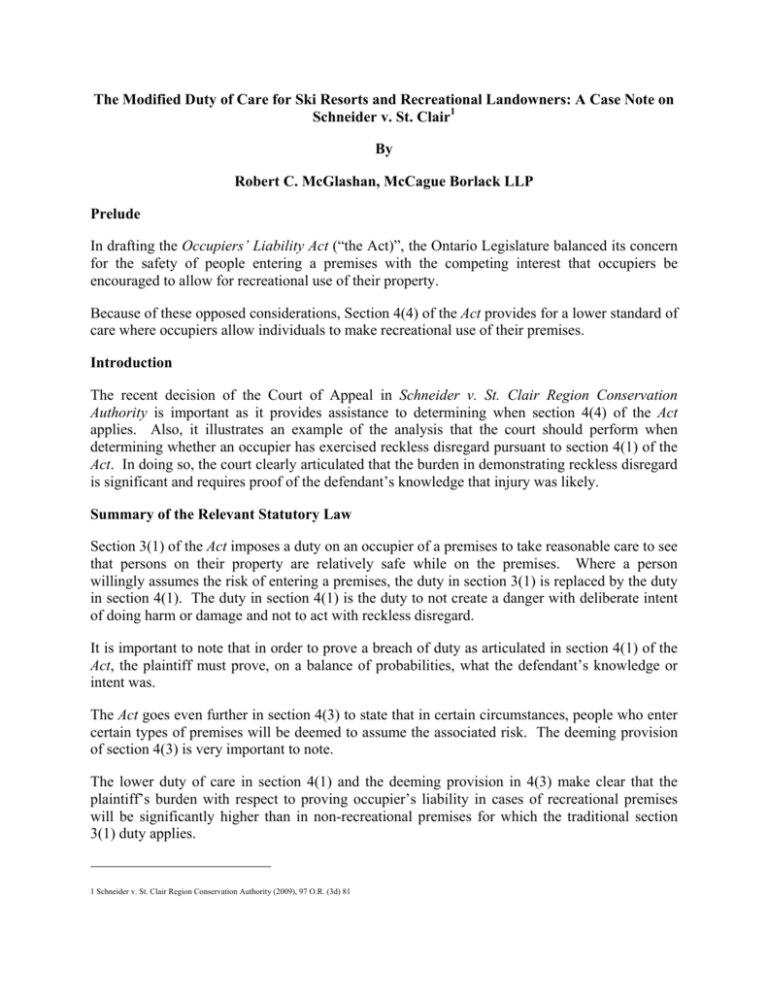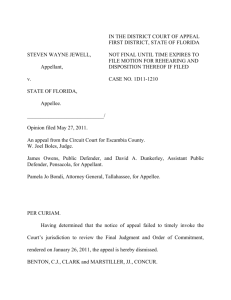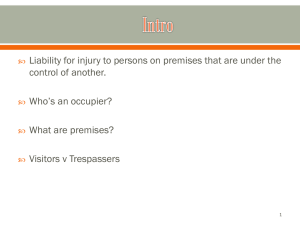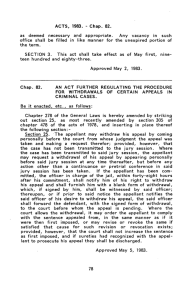The Modified Duty of Care for Ski Resorts and Recreational
advertisement

The Modified Duty of Care for Ski Resorts and Recreational Landowners: A Case Note on Schneider v. St. Clair1 By Robert C. McGlashan, McCague Borlack LLP Prelude In drafting the Occupiers’ Liability Act (“the Act)”, the Ontario Legislature balanced its concern for the safety of people entering a premises with the competing interest that occupiers be encouraged to allow for recreational use of their property. Because of these opposed considerations, Section 4(4) of the Act provides for a lower standard of care where occupiers allow individuals to make recreational use of their premises. Introduction The recent decision of the Court of Appeal in Schneider v. St. Clair Region Conservation Authority is important as it provides assistance to determining when section 4(4) of the Act applies. Also, it illustrates an example of the analysis that the court should perform when determining whether an occupier has exercised reckless disregard pursuant to section 4(1) of the Act. In doing so, the court clearly articulated that the burden in demonstrating reckless disregard is significant and requires proof of the defendant’s knowledge that injury was likely. Summary of the Relevant Statutory Law Section 3(1) of the Act imposes a duty on an occupier of a premises to take reasonable care to see that persons on their property are relatively safe while on the premises. Where a person willingly assumes the risk of entering a premises, the duty in section 3(1) is replaced by the duty in section 4(1). The duty in section 4(1) is the duty to not create a danger with deliberate intent of doing harm or damage and not to act with reckless disregard. It is important to note that in order to prove a breach of duty as articulated in section 4(1) of the Act, the plaintiff must prove, on a balance of probabilities, what the defendant’s knowledge or intent was. The Act goes even further in section 4(3) to state that in certain circumstances, people who enter certain types of premises will be deemed to assume the associated risk. The deeming provision of section 4(3) is very important to note. The lower duty of care in section 4(1) and the deeming provision in 4(3) make clear that the plaintiff’s burden with respect to proving occupier’s liability in cases of recreational premises will be significantly higher than in non-recreational premises for which the traditional section 3(1) duty applies. 1 Schneider v. St. Clair Region Conservation Authority (2009), 97 O.R. (3d) 81 -2The relevant provisions of the Occupiers’ Liability Act are: Occupier’s duty 3(1) An occupier of premises owes a duty to take such care as in all the circumstances of the case is reasonable to see that persons entering on the premises, and the property brought on the premises by those persons are reasonably safe while on the premises. Idem (2) The duty of care provided for in subsection (1) applies whether the danger is caused by the condition of the premises or by an activity carried on on the premises. Risks willingly assumed 4(1) The duty of care provided for in subsection 3 (1) does not apply in respect of risks willingly assumed by the person who enters on the premises, but in that case the occupier owes a duty to the person to not create a danger with the deliberate intent of doing harm or damage to the person or his or her property and to not act with reckless disregard of the presence of the person or his or her property. Trespass and permitted recreational activity (3) A person who enters premises described in subsection (4) shall be deemed to have willingly assumed all risks and is subject to the duty of care set out in subsection (1), (c) where the entry is for the purpose of a recreational activity and, (i) no fee is paid for the entry of activity of the person, other than a benefit or payment received from a government or government agency or a non-profit recreation club or association, and (ii) the person is not being provided with living accommodation by the occupier. Premises referred to in subs. (3) (4) The premises referred to in subsection (3) are, (a) a rural premise that is, (i) used for agricultural purposes, including land under cultivation, orchards, pastures, woodlots and farm ponds, (ii) vacant or underdeveloped premises, (iii) forested or wilderness premises; -3(b) golf course when not open for playing; (c) utility rights-of-way and corridors, excluding structures located thereon; (d) unopened road allowances; (e) private roads reasonably marked by notice as such; and (f) recreational trails reasonably marked by notice as such. Facts In Schneider, the plaintiff was injured while cross country skiing at Coldstream Conservation Area when her ski struck a concrete wall hidden below the snow. Coldstream Conservation Area has no residential or commercial development on it and the surrounding community is not urban. The park has a trail system marked by signs and maps. The public are encouraged to use the park and it is free to enter. During the summer months, from May to October, the conservation area is maintained by the township. During this time, the conservation area is used to a variety of activities including picnicking and hiking. During this time, the township maintains the grounds and provides clean washroom facilities. During the winter months, the conservation area is used for cross country skiing, tobogganing and hiking. During this time, the township provides no maintenance. None of the trails are groomed, none of the ice is maintained and washrooms are not provided. The Accident On January 30, 2005, the plaintiff, a former Olympic athlete and professor of kinesiology at the University of Western Ontario was skiing in the conservation area. She began skiing on a trail but decided to ski off the trail. The plaintiff had spent the day playing with her husband and children and skiing on trails. Just prior to the accident, she decided to ski off the trail. She skied into a 6-inch concrete wall and fell down. She fractured three bones in her right ankle. She made a claim for pain and suffering, loss of enjoyment of life and loss of income. Trial Decision It was held that the defendant was bound by a duty of care pursuant to section 3(1) of the Act to take reasonable care to see that each person and their property are reasonably safe while on the premises. The trial judge held that the lesser duty established by section 4(1) did not apply and the premises did not fall within section 4(4)(f) of the Act because the wall that the plaintiff collided with was not situated on one of the recreational trails. The court held that if the park did not fall within section 4(4) of the Act, that the defendant displayed a reckless disregard for the safety of the users of the park. The court allowed the plaintiff’s action and awarded her $115,170.58 less 20% for contributory negligence. The defendant appealed. -4Issues on Appeal The issues on appeal were: (1) Did the trial judge err in concluding that the modified duty of care provided in s. 4(1) of the Act did not apply because the premises were not captured by s. 4(4)? and (2) Did the trial judge err in finding that the appellant acted with reckless disregard for the safety of users of the park? Appeal Decision 1(a). Whether the trial judge erred in concluding that the lesser duty of care established by section 4(1) did not apply because the premises were not captured by section 4(4) Court of Appeal considered whether section 4 of the Act applied to the appellant in the circumstances of the case. In order to do this, it was necessary for the Court of Appeal to consider the purpose of the Act and section 4, in particular. Purpose of the Act The Court of Appeal cited Waldick v. Malcolm [1991] 2 S.C.R. 456 where the Supreme Court explained that the goals of the Act were “to promote, and indeed, require where circumstances warrant, positive action on the part of occupiers to make their premises reasonably safe” p. 477 (S.C.R). The Court of Appeal also held that section 4 of the Act and specifically, section 4(4)(f) were specifically to encourage occupiers to make their lands available to the public for recreational use. The Court of Appeal held that imposing a lesser duty of care on occupiers of recreational trails of all kinds was warranted to encourage occupiers to make their lands available for recreational activities. The Court of Appeal held that section 4(1), 4(3)(c) and 4(4)(f) of the Act taken together were such that a person who enters recreational trails, reasonably marked by notices as such, for the purpose of a recreational activity without payment of any fees is deemed to have willingly assumed the risk associated with the activity. In these cases, the duty of the occupier to the person is “to not create a danger with a deliberate intent of doing harm or damage to the person or his property and to not act with reckless disregard for the presence of the person on his or her property”. The Court of Appeal held that it was clear that the Legislature intended that section 4 of the Act encourage occupiers to promote the use of recreational trails on their land by members of the public. The Court of Appeal held that the trial judge erred in finding that the park was not a recreational trail for the purposes of section 4(4)(f) and in finding that the duty of care established by section 4(1) did not apply. The Court of Appeal held that nothing in the records suggested that the recreational trail being used by the plaintiff was used for any purpose other than recreation or that the area of where the injury occurred was used at that time of year for any purpose at all. -5The Court of Appeal held that the objective section 4(4)(f) was to encourage occupiers to allow recreational use of marked trails by imposing a modified duty of care. Therefore, it would make little sense to limit the lesser duty to users when they were on the trail but expect a higher duty when the individual left the trail. The occupier had no effective way to police the trails or the areas off the trails and that the effect of the trial judge decision would be to impose a duty on the occupier to make the off-trail area of the property safer than the area on the trail. Furthermore, it was not relevant that in the summer, the park was used for various recreational activities such as soccer and picnicking. In the winter, the park was essentially closed. Neither the appellant nor the township carried out any maintenance activities or have any presence in the park. The fact that the appellant allowed and promoted the use of the park’s recreational trails in winter for cross country skiing was precisely what section 4(4)(f) was intended to encourage. The plaintiff acknowledged the only reason she was on the property was to cross country ski. She began her trip on the recreational trails and she was injured when she ventured off the trails. 2. Whether the trial judge erred in finding that the appellant had acted with reckless disregard for the safety of users of the park The Court of Appeal held that the trial judge erred in his interpretation of the term “reckless disregard” as it is used in section 4(1) of the Act. The trial judge’s analysis of the appellant’s failure to meet its duty of cares is relatively short and no separate analysis of section 3(1) and 4(1) duties was carried out. Court of Appeal held that the trial judge may have conflated the duties of care set out in section 3(1) and 4(1). The Court of Appeal cited Cormack v. Mara (Township) (1989), 68 O.R. (2d) 716 (C.A.) at p.724 for the proposition that acting with reckless disregard of the presence of a person means “doing of omitting to do something which he or she should recognize as likely to cause damage or injury to the person present on his or her premises, not caring whether such damage or injury results”. The trial judge finding that the appellant knew or ought to have known that the concrete wall will likely be covered in snow and thus be hidden from view and that the park was regularly used by cross country skiers may provide a sufficient basis for concluding a breach of the section 3(1) duty of care but that did not provide a sufficient basis for concluding that the appellant acted with “reckless disregard” to the presence of users of the park. To reach this level of “reckless disregard” more is required. There is no suggestion in the record that the appellant had specific knowledge that the concrete wall, depending on snow conditions, would be hidden from view of cross country skiers and thus pose a risk of injury to a skier choosing to leave the trail. The concrete wall had been in place for more than a decade, apparently without incident or suggestion that, in winter, it constituted a hazard or trap to the users of the park. The Court of Appeal held that while the appellant knew that the cross country skiers used the park, and in fact encouraged such use, this in no way constitutes proof that the appellant knew or ought to have known that cross country skiers would occasionally travel off the marked trails to ski down to the lake in a manner done by the plaintiff and that doing so could lead to injury. In order to constitute recklessness, the court must find that the occupier knew or should have known that injury was likely. That finding was not made by the trial judge and there was no basis for making such a finding. The Court of Appeal held that there was no evidence that the appellant knew or ought to have known that cross country skiers were likely to collide with a partially snow covered wall in a manner such that a serious injury could or was likely to result. -6The Court of Appeal distinguished the case at bar from the situation in Onyschuk v. Silver Harbour Acres Limited2, which the trial judge relied on to suggest that the wall hidden beneath the snow was a trap and that the appellant displayed a reckless disregard for the safety of the users of the park. In Onyschuk, the defendant placed a cable across a part of a roadway that the defendant knew was frequently used by snowmobilers. The defendant also “knew the condition of the cable immediately prior to the accident, that was approximately two feet from the ground at each end but it was covered by the snow in the center for at least two meters” and that it “must have been obvious to anyone that this very accident… was not only a distinct possibility, but a probability”3. The court held that this is not the circumstance in this case. The Defendants had not placed the wall across an area that they knew was frequently used by cross country skiers. They did not know the condition of the area immediately prior to the accident. It was not obvious that this type of accident was a probability or even a possibility. Therefore, circumstances in this litigation did not constitute a trap. Conclusion The Court of Appeal allowed the appeal and set aside the trial judgement. This case provides a very useful discussion of the purposes of the Act and the duties of care articulated in section 3 and 4 of the Act. This case demonstrates that the duty of care owed by occupiers of premises used for recreation is significantly modified from the general duty of care owed and that the requirements of proving “reckless disregard” are significant. The Court of Appeal’s analysis in Schneider articulates courts’ recognition of the Legislature’s efforts to balance the concern for safety of people entering a premises with the competing public policy goal that landowners be encouraged to allow recreational use of their property. The Court of Appeal’s decision illustrates not only the reasoning behind the different duties of care articulated in sections 3 and 4 of the Act, it also provides a better understanding of their application. 2 (1984), 49 O.R. (2d) 762 3 Ibid at p. 767





